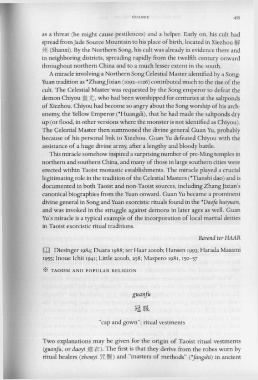Page 495 - The Encyclopedia of Taoism v1_A-L
P. 495
GUANFU 455
as a threat (he might cause pestilences) and a helper. Early on, his cult had
spread from]ade Source Mountain to his place of birth, located in Xiezhou fm
j'H (Shanxi). By the Northern Song, his cult was already in evidence there and
in neighboring districts, spreading rapidly from the twelfth century onward
throughout northern China and to a much lesser extent in the south.
A miracle involving a Northern Song Celestial Master identified by a Song-
Yuan tradition as *Zhang]ixian (I092-II26) contributed much to the rise of the
cult. The Celestial Master was requested by the Song emperor to defeat the
demon Chiyou :§'t'it, who had been worshipped for centuries at the saltponds
of Xiezhou. Chiyou had become so angry about the Song worship of his arch-
enemy, the Yellow Emperor (*Huangdi), that he had made the saltponds dry
up (or flood, in other versions where the monster is not identified as Chiyou).
The Celestial Master then summoned the divine general Guan Yu, probably
because of his personal link to Xiezhou. Guan Yu defeated Chiyou with the
assistance of a huge divine army, after a lengthy and bloody battle.
This miracle somehow inspired a surprising number of pre-Ming temples in
northern and southern China, and many of those in large southern cities were
erected within Taoist monastic establishments. The miracle played a crucial
legitimating role in the tradition of the Celestial Masters (*Tianshi dao) and is
documented in both Taoist and non-Taoist sources, including Zhang]ixian's
canonical biographies from the Yuan onward. Guan Yu became a prominent
divine general in Song and Yuan exorcistic rituals found in the *Daofa huiyuan,
and was invoked in the struggle against demons in later ages as well. Guan
Yu's miracle is a typical example of the incorporation of local martial deities
in Taoist exorcistic ritual traditions.
Barend ter HAAR
m Diesinger 1984; Duara I988; ter Haar 2ooob; Hansen I993; Harada Masami
I955; Inoue Ichii I94I; Little 2ooob, 258; Maspero I98I, 150-57
* TAOISM AND POPULAR RELIGION
guanfo
Jtt. JlR
"cap and gown"; ritual vestments
Two explanations may be given for the origin of Taoist ritual vestments
(guanJu, or daoyi :i!!~) . The first is that they derive from the robes worn by
ritual healers (zhouyi % mn and "masters of methods" (*fangshi) in ancient

